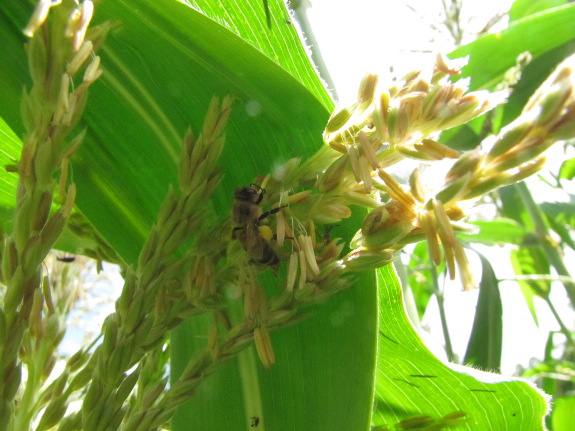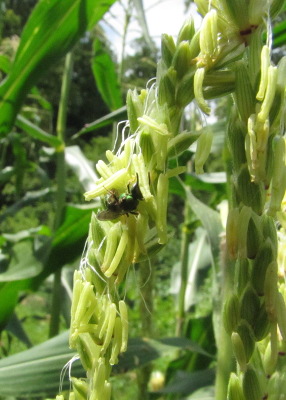
Honeybees collecting corn pollen

Soon after nadiring
the Warre hive the
second time, I saw a
huge mass of bees in the air above their home. This was during
the sweltering weather we faced at the end of June, and I thought for a
few minutes that the hive might be overheating and the bees
absconding. However, it turned out that all the fuss was merely a
huge brood of new workers taking their bearings before getting to work.
 Despite all of the extra
hands to make light work, two weeks later, the colony still hasn't
moved down into the fourth box. I suspect the slowdown is mostly
due to a week of rain --- bees don't do well flying between raindrops,
so they're stuck at home eating through their winter stores.
Despite all of the extra
hands to make light work, two weeks later, the colony still hasn't
moved down into the fourth box. I suspect the slowdown is mostly
due to a week of rain --- bees don't do well flying between raindrops,
so they're stuck at home eating through their winter stores.
When the clouds cleared
Saturday, I saw bees all over, but was surprised to notice that the
busiest spot seemed to be our patch of blooming sweet corn. Corn
is supposed to be wind-pollinated, but from the bumblebees, sweatbees,
and honeybees buzzing around the flowers, I have to conclude that
insects do a bit of work there as well.
Hopefully we'll get
enough of a break from the rain that the bees can visit the buckwheat
and clover, too, and fill up on nectar to help them drawn out the
foundationless frames. They've still got a lot of work to do so
that I don't have to embark on fall feeding to top up their winter
honey.
Want more in-depth information? Browse through our books.
Or explore more posts by date or by subject.
About us: Anna Hess and Mark Hamilton spent over a decade living self-sufficiently in the mountains of Virginia before moving north to start over from scratch in the foothills of Ohio. They've experimented with permaculture, no-till gardening, trailersteading, home-based microbusinesses and much more, writing about their adventures in both blogs and books.
Want to be notified when new comments are posted on this page? Click on the RSS button after you add a comment to subscribe to the comment feed, or simply check the box beside "email replies to me" while writing your comment.

I have to ask what kind of corn are you growing?
I had thought that corn was not a major food source for honey bees.
Don't worry about the buckwheat. The bees will find it. And they will be all over it. You may notice that the bee activity stops in the afternoon because buckwheat stops producing nectar at some point during they day.
RDG --- This particular bed is "Early and Often Hybrid". It's supposed to be a sweet corn, but is odd --- much taller than I'm used to.
That said, I just noticed yesterday that the bees have found my second planting of corn (SugarPearl, another sweet corn), so I suspect it's not variety specific. It seems that a wind-pollinated plant would have lots of pollen going to waste, so it's not that surprising that bees go after it. After all, they gather from hazels and willows in the spring, which are also wind-pollinated.
Interesting tip about buckwheat running out of nectar partway through the day! That would explain why the big pollinators seem to be on it in the morning, then only little sweat bees later in the day. Presumably the little guys can lap up the bit that's left behind.
It is early September. This year I tried growing "super sweet" corn in my garden. This variety of corn is HIGHLY ATTRACTIVE to birds and to honey bees. I had to replant the seeds three times and in frustration finally resorted to my son's sling shot to hurl rocks toward the common towhees here. We did have good towhee production this year, but the foraging on such corn was unprecedented! When the corn finally bloomed it must have had fifty of more bees eagerly foraging on each plant!!!! I believe the high sugar content was a factor. This is a concern. Any comments? Other similar observations??? Rob (in Northern California)
Rob --- Although I can see why you'd be a bit gun shy, I can't see how the honeybees could be harming your corn. If anything, they might be helping the wind pollinate the kernels.
I doubt that the supersweet variety has anything to do with attracting bees (although I'll bet the sugar makes them very attractive to birds). Since corn is generally wind-pollinated, it doesn't produce any nectar. Instead, all bees on the corn are gathering pollen, which contains proteins and fats, but not sugar.